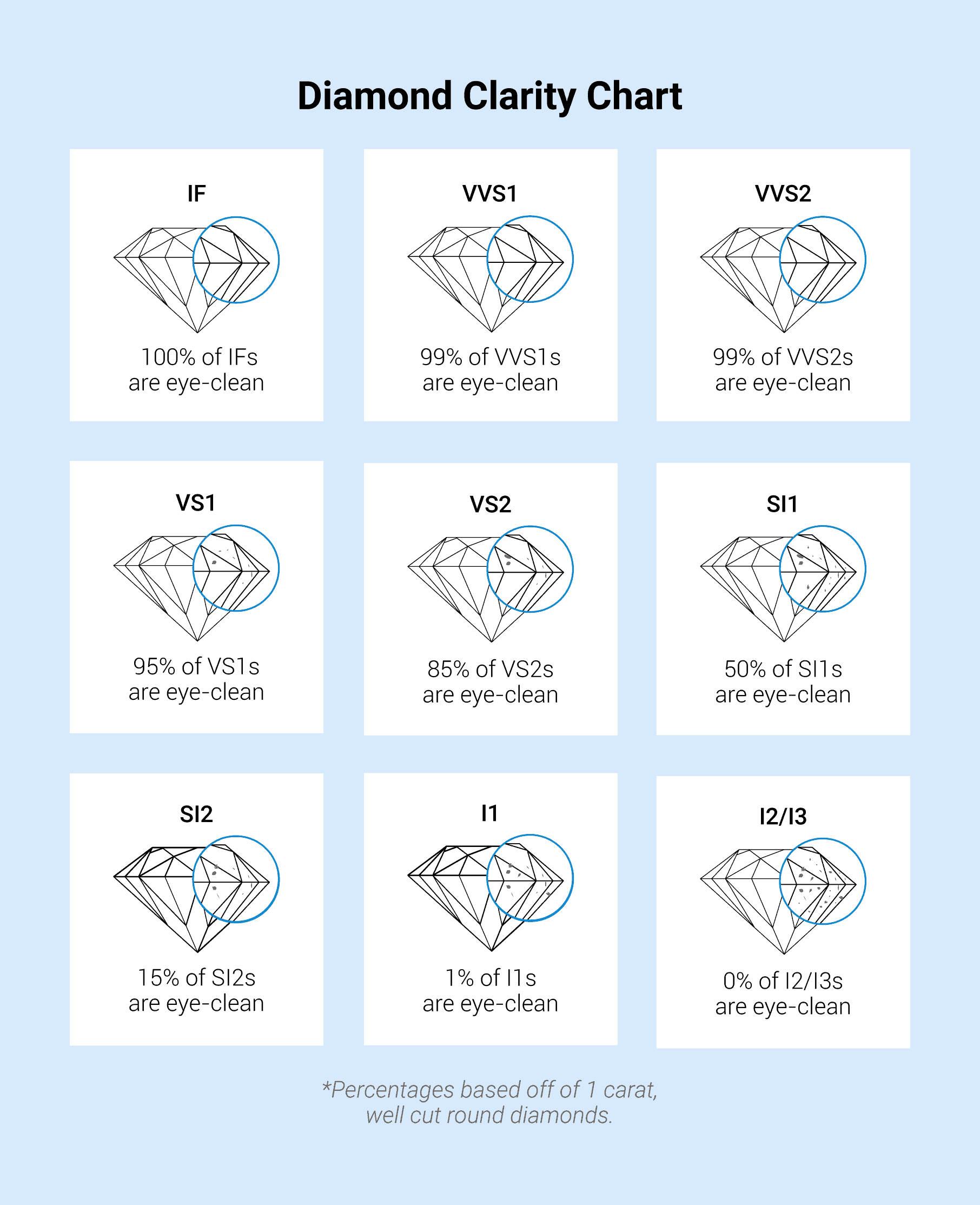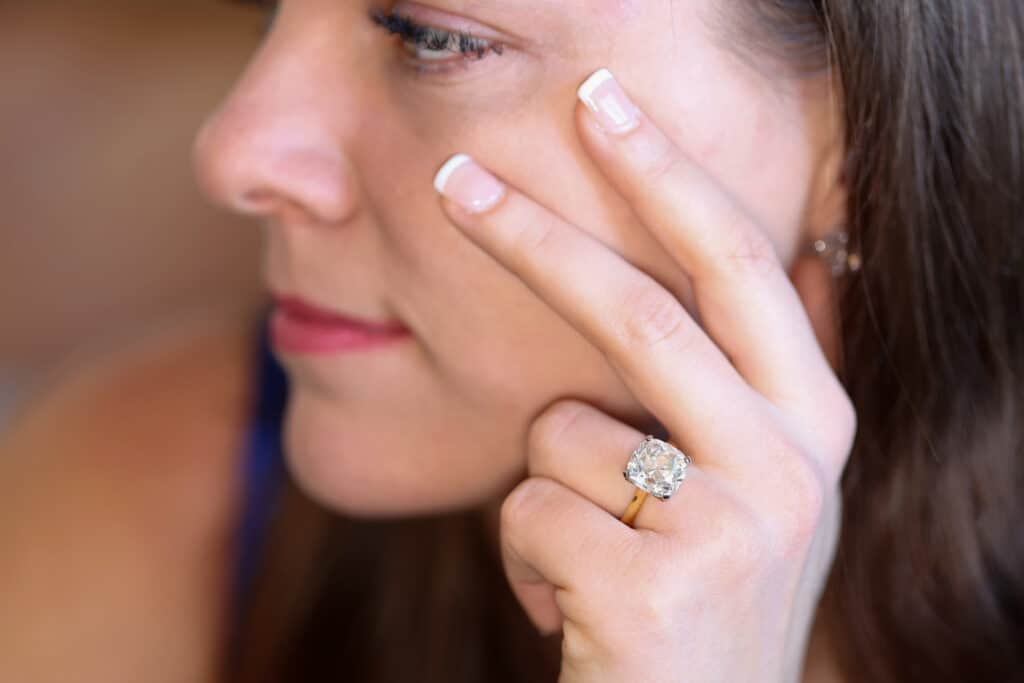A Guide To The Diamond Clarity Chart
Understanding diamond clarity charts and how to choose the best clarity grade for you.
We are reader-supported. Buying through any red colored link on our site may earn us commissions. Learn More.
Understanding diamond clarity charts and how to choose the best clarity grade for you.
Diamond clarity refers to the grade given to a diamond based on the imperfections and inclusions found in a diamond. The fewer inclusions and blemishes a diamond has, the higher grade it will receive on the diamond clarity chart. The clarity can have a significant impact on a diamond’s cost (it’s one of the diamond 4Cs – the main characteristics of a diamond). However, many imperfections that affect a diamond’s clarity grade aren’t visible to the naked or unaided eye.
In this article, we will discuss the different diamond grades and what the different types of inclusions are. More importantly, we will explain how you can use clarity to get the best bang for your buck when purchasing a diamond.
What is a diamond clarity chart?
What is the best clarity grade?
How to choose the right clarity grade
How are clarity grades determined?
What are the types of inclusions in diamond clarity?
Buying tips for diamond clarity
FAQs about clarity
Bottom line recommendation
Why you should trust us
While it’s true that you need to understand the GIA clarity scale (diamond prices are calculated in large part due to their clarity grade), what you need to know is how to find an eye-clean diamond. This chart shows you what your chances are of finding an eye-clean diamond in a particular grade.

Those percentages are based on your typical one carat diamonds. So you are best off looking for a diamond in the VS2 – SI2 range when purchasing a one carat diamond. It’s true that the overwhelming majority of SI2 diamonds will not be eye-clean, but who cares? You aren’t buying all the SI2 diamonds, you are picking out the one for you.
As diamonds get larger, the inclusions get larger as well. You’ll find that it’s harder to find an eye-clean 2 carat SI2 diamond than it is to find a one carat. It’s a bit of an art form to pick a diamond based off of the videos on James Allen or Blue Nile (or other reputable online retailers), so feel free to contact us and we’ll help you find the perfect diamond. Everyone on our team has picked out thousands of diamonds for our readers.
If you are looking at the diamond in a physical retailer, be sure to walk around the store and see if you can find the inclusions in different lighting scenarios. Some inclusions will be hidden by the sparkle under the perfect lighting at the desk, then you’ll be sitting in your kitchen and notice a black mark. Once you see it, that is all you’ll ever see when looking at your diamond.
To provide shoppers with an understanding of each diamond’s clarity level, grading institutes like the Gemological Institute Of America (GIA) use diamond clarity charts to judge diamonds based on their appearance and give each stone a clarity grade within a given scale.
Diamond clarity scales range from I (meaning “included”) to FL (meaning “flawless”). Each clarity grade has subgrades that provide more information about the visibility of inclusions in the diamond.
If you want some help finding a diamond that has inclusions, yet is eye-clean, feel free to contact us.
When educating yourself about diamonds, it’s easy to get lost in the technical details. You may end up asking a question and receiving a technically correct answer, but it will result in you making a bad choice when purchasing a diamond. “What is the best clarity grade for a diamond” is a perfect example of this.
The answer to that question is seemingly simple. A Flawless (FL) diamond clarity grade is the highest possible grade a diamond can receive. Since it’s the best grade, you should try to get one with that grade (or as close to it as possible), right? WRONG!
In many ways a diamond clarity grade is meaningless. We’ll explain all the technical parameters regarding clarity below, but the most important factor is this: Can you see the inclusions with your naked eye (without a magnifying glass or microscope) once the diamond is mounted in the ring? Everything else (with a few exceptions) is just noise.
According to the GIA, “Many inclusions and blemishes are too tiny to be seen by anyone other than a trained diamond grader. To the naked eye, a VS1 and an SI2 diamond may look exactly the same..”
Take a look at this beautiful 1 carat SI1 diamond from James Allen. There is absolutely no way you will see the inclusions once the diamond is mounted in a ring. Compare it to this 1 carat internally flawless diamond. If you had those diamonds side by side, you would not be able to tell the difference.
There is one big difference between those two diamonds that everyone can notice, that is the price. The SI1 clarity grade costs $2,410 while the internally flawless diamond is $3,790. So you are paying a whopping $1,380 premium for a characteristic that has zero impact on the diamond’s appearance.
You are better off putting that money towards something that will make the diamond look better. For example, you can get a larger diamond or you can focus on the cut (which will make the diamond more brilliant). Better yet, you can just save that money.
Natural diamonds are formed in the earth’s mantle layer at a depth ranging between 80-120 miles, and they face extreme heat up to 2,200 degrees Fahrenheit. While their growth takes between one billion to three billion years, only the rarest diamonds emerge in perfect condition. Most often they are imperfect and contain varying amounts of internal inclusions and surface blemishes.
As the AGS explains, inclusions usually develop as a result of heat and pressure, while blemishes tend to appear during the cutting and polishing process, or as a result of wear that affects the surface of the diamond.
When determining the clarity of diamonds on a clarity scale, experts will note the appearance of the diamond when it is face up, with a microscope at 10x magnification and eye visibility. However, to identify any diamond inclusions there may be, a higher power than 10x will be used. Otherwise, it may be too difficult to determine.
Artificial Intelligence is playing a more prominent role in diamond grading. According to Rapaport Magazine, “Today, using artificial intelligence (AI) has become a go-to method for grading diamonds.” The GIA developed its own AI-based system for grading diamonds in partnership with IBM, with the system going into operation in GIA labs in 2020.
The GIA AI clarity grading “is built on globally accepted standards — the GIA International Diamond Grading System — and [on the] GIA’s decades of research and analysis from tens of millions of diamonds” added Tom Moses of the GIA.
Five factors play a significant role in how a diamond is graded, and how its “score” on the diamond clarity chart is determined. These five roles in diamond grading include size, nature, number, location, and the relief of the inclusions.
1. Size – The size of the inclusions in a diamond is one of the most important factors in determining its clarity grade. The bigger the inclusions, the larger the impact they’ll have on a diamond’s appearance.
2. Nature – Nature refers to the type of inclusions that can be seen in the diamond, as well as the depth of these inclusions within the diamond.
3. Number – Grading entities also take into account the number of inclusions within a diamond. If a diamond has a large number of inclusions, even if small, they can have a large impact on its appearance and clarity.
4. Location – The location of an inclusion refers to where on the diamond the inclusion is located. If the inclusion is situated in closer proximity to the center of the table, then the inclusion is more visible to the eye and the clarity grade will be impacted much more.
5. Relief – The relief is referring to how noticeable the inclusions are in comparison with the diamond — put simply, how much contrast there is between the diamond and the inclusions. The higher the relief, the darker the color may seem which can affect diamond grading.

Although the term inclusion is often used to refer to any type of imperfection in a diamond, there are several different types of inclusions that can affect a diamond’s appearance.
Here are some of the most common types of inclusions and the effect each type can have on a diamond’s clarity:
When it comes to assessing a diamond’s inclusions, it’s always best to consider the advice of a professional. You should also look at the diamond’s GIA certificate for a fuller understanding of its inclusions and imperfections.
Before purchasing a diamond, there are a few things to keep in mind to get the best value and beauty, especially when it comes to clarity.
It’s very easy to overpay for clarity. In most cases, a VS1 or VS2 diamond will be eye-clean just like an FL diamond, but cost far less. Instead of focusing on a certain clarity grade, choose the lowest clarity grade that still presents an eye-clean diamond. Your budget is better spent on factors that more greatly impact a diamond’s beauty, like the quality of a diamond cut.
The best clarity grade depends on the shape of your diamond. As we mentioned above, some diamond shapes are much better at hiding inclusions and other imperfections than others.
| Round Cut Diamonds | The facet pattern of the round brilliant cut makes it excellent at making inclusions less visible. Choose a clarity grade of VS2 or SI1 for a round brilliant cut diamond of under 1 carat (sometimes even SI2 doesn’t have visible inclusions). For Round Cut diamonds 1 carat or over, a VS1 or VS2 will give you an eye-clean stone. The larger the diamond (carat weight can be a factor), the easier it is to see inclusions. |
| Emerald Cuts, Asscher Cuts and Baguettes | All these step-cut diamond shapes have large tables (top surface areas) that allow for a clear, unobstructed look into the diamond. This means that they display inclusions more clearly than other diamond shapes. For these diamond shapes, we recommend limiting your search only to diamonds with a clarity grade of VS2 or better. |
| Cushion Cut, Oval Cut, Radiant Cut, Marquise, and Pear Shaped (Princess Cut) | As these shapes hide inclusions better than other shapes, you can drop down to the SI1 to SI2 clarity grade range and still find eye-clean diamonds. These clarity grades will help you to get more for your budget. |
Besides looking at the certificate and clarity plot, carefully review the diamond to look for visible inclusions. Online vendors, particularly James Allen and Blue Nile, have high-end photography for just this purpose.
Look to see if you notice any blemishes or inclusions. If you do notice some, take note of where they are on the diamond. Are they in the middle of the table, where they’ll be visible, or near the edge of the diamond, where they could be covered up by the setting?
The main goal is to find a diamond that’s eye-clean without overpaying. If you’re not sure, get an expert’s opinion.
Pro Tip: We recommend buying a diamond online, not just because of the value that’s available, but also because of the ease of comparing diamonds. Instead of the bright lighting in jewelry stores that can hide imperfections, online vendors offer objective, high-quality photography.
The best diamond clarity grade is Flawless (FL) clarity. Flawless diamonds are extremely rare, with no internal or external imperfections, even when viewed under intense magnification.
Though Flawless/Internally Flawless is the highest diamond clarity rating, the best clarity to get is the lowest grade which appears clean to the naked eye, which can be anything from VS1 to, in some cases, as low as SI1 or SI2. Under normal viewing conditions, it’s virtually impossible for the regular person to tell the difference between one of these diamonds and a Flawless diamond.
SI clarity diamonds can, in some cases, look as good under normal viewing conditions as a Flawless diamond. Inspect each diamond individually to be sure, as approximately 50% of SI1 diamonds qualify as eye-clean.
Clarity has little effect on a diamond’s sparkle (or, more accurately, its fire and brilliance). As long as the diamond’s clarity grade is SI2 or higher, there should be no effect on the way it interacts with and reflects light.
We understand that buying a diamond can be a confusing process, especially when it comes to subjective things such as determining if a diamond is eye-clean.
If you’re not sure what to look for, confused by different clarity grades or diamond color grading, or just want an expert to guide you through the process, don’t hesitate to contact us.
We’ve helped thousands of our readers buy beautiful engagement rings and other high-quality diamond jewelry, and we’re happy to help you too.
A lower clarity eye-clean diamond will look identical to a flawless diamond assuming all else is equal (yet will cost far far less). Be sure to focus on an online retailer that has high quality videos of each diamond (like James Allen and Blue Nile).




Before you buy a diamond, get personal buying advice from industry veterans. We'll help you get the best diamond for the money.
DISCLAIMER: We don't use your email for marketing. Period.
A diamonds’ price is determined primarily by the 4 Cs of the diamond. On the wholesale level, diamond prices are first based on a diamond shape and
Buying an engagement ring is often one of the first major purchases in a person's life. The process can be fraught with tension as there are so m
A wide range of 1 carat diamonds exist both in online markets and local diamond jewelry stores. Not only are there significant differences in beauty
Please enter your email address to receive your 25% off coupon code:
Here is your coupon code: GFDSF3GF
Comments
JP
December 18, 2023
Reply:
Mike Fried
December 19, 2023
RA
December 22, 2023
Reply:
Mike Fried
December 23, 2023
LO
January 3, 2024
Reply:
Mike Fried
January 5, 2024